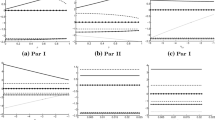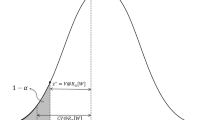Abstract
By introducing a stochastic element to the double-jump diffusion framework to measure the Knight uncertainty of asset return process, this paper builds the model of dynamic portfolio choice, which maximizes the expected utility of terminal portfolio wealth. Through specifying the state function of uncertainty-aversion, it utilizes the max-min method to derive the analytical solution of the model to study the effect of the time-varying, jumps, and Knight uncertainty of asset return process on dynamic portfolio choice and their interactions. Results of comparative analysis show: The time-varying results in positive or negative intertemporal hedging demand of portfolio, which depends on the coefficient of investor’s risk aversion and the correlation coefficient between return shift and volatility shift; the jumps in asset return overall reduce investor’s demand for the risky asset, which can be enhanced or weakened by the jumps in volatility; due to the existing of the Knight uncertainty, the investor avoids taking large position on risky asset, and the resulting is the improving of portfolio’s steady and immunity. At last, an empirical study is done based on the samples of Shanghai Exchange Composite Index monthly return data from January 1997 to December 2009, which not only tests the theoretical analysis but also demonstrates that the proposed method in the paper is useful from the aspect of portfolio’s equivalent utility.
Similar content being viewed by others
References
D. Levhari and T. Srinivasan, Optimal savings under uncertainty, Review of Economic Studies, 1969, 59: 153–165.
P. A. Samuelson, Lifetime portfolio selection by dynamic stochastic programming, Review of Economics and Statistics, 1969, 51: 239–246.
N. H. Hakansson, On optimal myopic portfolio policies with and without serial correlation of yields, Journal of Business, 1970, 44(3): 324–334.
R. C. Merton, Optimum consumption and portfolio rules in a continuous-time model, Journal of Economic Theory, 1971, 3: 373–413.
D. Breeden, An intertemporal asset pricing model with stochastic consumption and investment opportunities, Journal of Financial Economics, 1979, 7(3): 265–296.
J. Liu, Portfolio selection in stochastic environment, Review of Financial Studies, 2007, 20(1): 1–39.
J. Liu, F. Longstaff, and J. Pan, Dynamic asset allocation with event risk, Journal of Finance, 2003, 58(1): 231–259.
D. Dequech, The new institutional economics and the theory of behavior under uncertainty, Journal of Economic Behavior and Organization, 2006, 59: 109–131.
R. Klein and V. Bawa, The effect of estimation risk on optimal portfolio choice, Journal of Financial Economics, 1976, 3(3): 215–231.
V. Bawa, S. Brown, and R. Klein, Estimation Risk and Optimal Portfolio Choice, North Holland, Amsterdam, 1979.
S. Kandel and R. Stambaugh, On the predictability of stock returns: An asset-allocation perspective, Journal of Finance, 1996, 51(1): 385–424.
M. J. Brennan, The role of learning in dynamic portfolio decisions, European Finance Review, 1998, 1: 295–306.
M. J. Brennan and Y. H. Xia, Stock return volatility and equity premium, Journal of Monetary Economics, 2001, 47: 249–283.
N. Barberis, Investing for the long run when returns are predictable, Journal of Finance, 2000, 55(1): 225–264.
Y. H. Xia, Learning about predictability: The effects of parameter uncertainty on dynamic asset allocation, Journal of Finance, 2001, 56(1): 205–246.
W. D. Meng and C. L. He, The choice of dynamic portfolio based on the learning behavior, Systems Engineering — Theory & Practice, 2007, 27(9): 38–46.
W. D. Meng and C. L. He, The choice of dynamic portfolio based on the information update, Chinese Journal of Management Science, 2007b, 15(4): 21–27.
C. J. Yang and H. W. Chen, Parameter uncertainty and investor’s portfolio choice: Evidence from China stock market, Chinese Journal of Management Science, 2008, 16(3): 37–43.
L. Pastor, Portfolio selection and asset pricing models, Journal of Finance, 2000, 55(1): 179–223.
L. Pástor and R. Stambaugh, Comparing asset pricing models: An investment perspective, Journal of Financial Economics, 2000, 56(3): 335–381.
J. Tu and G. Zhou, Data-generating process uncertainty: What difference does it make in portfolio decisions, Journal of Financial Economics, 2004, 72(2): 385–421.
Z. Y. Wang, Shrinkage is applied to test the effect of uncertainty about model on portfolio choice, Review of Financial Studies, 2005, 18(3): 689–733.
L. Garlappi, R. Uppal, and T. Wang, Portfolio selection with parameter and model uncertainty, Review of Financial Studies, 2007, 20: 41–81.
W. L. Zhu and H. L. Liu, Robust portfolio of dynamic asset allocation, Chinese Journal of Management Science, 2007, 15(3): 19–24.
C. L. He and W. D. Meng, Dynamic portfolio choice under uncertainty-aversion, Journal of Systems Engineering, 2009, 24(2): 150–155.
I. Gilboa and D. Schmeidler, Maxmin Expected utility with non-unique prior, Journal of Mathematical Economics, 1989, 18: 141–153.
V. Golosnoy and Y. Okhrin, General uncertainty in portfolio selection: A case-based decision approach, Journal of Economic Behavior and Organization, 2008, 67: 718–734.
D. Duffie, J. Pan, and K. J. Singleton, Transform analysis and asset pricing for affine jumpdiffusions, Econometrica, 2000, 68(6): 1343–1376.
T. S. Kim and E. Omberg, Dynamic nonmyopic portfolio behavior, Review of Financial Studies, 1996, 9(1): 141–161.
G. J. Jiang and J. L. Knight, Estimation of continuous-time process via the empirical characteristic function, Journal of Business and Economic Statistics, 2002, 20(2): 198–212.
Author information
Authors and Affiliations
Corresponding author
Additional information
This research is supported by National Natural Science Foundation of China under Grant Nos. 71271003 and 71171003, Programming Fund Project of the Humanities and Social Sciences Research of the Ministry of Education of China under Grant No. 12YJA790041, Natural Science Foundation of Anhui Province under Grant No. 1208085MG116, and Key Program of Natural Science Research of High Education of Anhui Province of China under Grant No. KJ2011A031.
This paper was recommended for publication by Editor Shouyang WANG.
Rights and permissions
About this article
Cite this article
He, C., Meng, W. Dynamic portfolio choice under the time-varying, jumps, and knight uncertainty of asset return process. J Syst Sci Complex 25, 896–908 (2012). https://doi.org/10.1007/s11424-012-9367-2
Received:
Revised:
Published:
Issue Date:
DOI: https://doi.org/10.1007/s11424-012-9367-2




